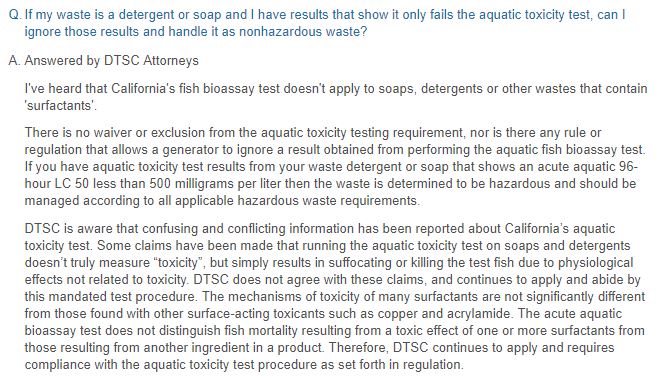The answer is yes. If they fail the aquatic toxicity test.
Contact me with any questions you may have about the generation, identification, management, and disposal of hazardous waste Daniels Training Services, Inc. 815.821.1550 |
Below is the text from the FAQ page of the California Department of Toxic Substances Control (DTSC):
I’ve heard that California’s fish bioassay test doesn’t apply to soaps, detergents or other wastes that contain ‘surfactants’.
There is no waiver or exclusion from the aquatic toxicity testing requirement, nor is there any rule or regulation that allows a generator to ignore a result obtained from performing the aquatic fish bioassay test. If you have aquatic toxicity test results from your waste detergent or soap that shows an acute aquatic 96-hour LC 50 less than 500 milligrams per liter then the waste is determined to be hazardous and should be managed according to all applicable hazardous waste requirements.
DTSC is aware that confusing and conflicting information has been reported about California’s aquatic toxicity test. Some claims have been made that running the aquatic toxicity test on soaps and detergents doesn’t truly measure “toxicity”, but simply results in suffocating or killing the test fish due to physiological effects not related to toxicity. DTSC does not agree with these claims, and continues to apply and abide by this mandated test procedure. The mechanisms of toxicity of many surfactants are not significantly different from those found with other surface-acting toxicants such as copper and acrylamide. The acute aquatic bioassay test does not distinguish fish mortality resulting from a toxic effect of one or more surfactants from those resulting from another ingredient in a product. Therefore, DTSC continues to apply and requires compliance with the aquatic toxicity test procedure as set forth in regulation.
And here’s a screen shot of the question on the DTSC website:
It should come as no surprise that the state regulations of California for the cradle-to-grave management of hazardous waste are more broad and more stringent than the Federal rule. The California regulations are so broad in their definition of hazardous waste that most materials discarded (including soaps and detergents) will be a non-RCRA hazardous waste unless the generator of the waste is able to prove otherwise. A non-RCRA hazardous waste is regulated as a hazardous waste only within California. (The other category of hazardous waste in California – RCRA hazardous waste – is either listed as a hazardous waste or displays a hazardous waste characteristic per the Federal regulations and so is a hazardous waste both within and without California.)
Like this article? Subscribe to my Monthly Newsletter No marketing emails! |
If your state has an authorized hazardous waste program – and most of them do – then the standard format RCRA training won’t do. You must have training that covers the Federal regulations and those of your state. For that you require my Onsite Training or my Webinar Training, both of which can be tailored to the Federal and state regulations that apply to the waste you generate at your facility.
While you’re at it throw in my HazMat Employee training required by the USDOT/PHMSA to ensure everyone has the training they need to safely manage hazardous waste from cradle-to-grave.

